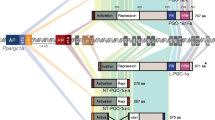Abstract
The peroxisome proliferator-activated receptors (PPARs) belong to the nuclear hormone receptor superfamily. To date, three different PPAR isotypes, namely PPAR-α, -δ, and -γ, have been identified in vertebrates and have distinct patterns of tissue distribution. Like all nuclear receptors, the human PPAR-γ (hPPAR-γ) is characterized by a modular structure composed of an N-terminal A/B domain, a DNA-binding domain with two zinc fingers (C domain), a D domain, and a C-terminal ligand-binding domain (E/F domain). Human PPAR-γ exists in two protein isoforms, hPPAR-γ1 and -γ2, with different lengths of the N-terminal. The hPPAR-γ2 isoform is predominantly expressed in adipose tissue, whereas hPPAR-γ1 is relatively widely expressed. Human PPAR-γ plays a critical physiological role as a central transcriptional regulator of both adipogenic and lipogenic programs. Its transcriptional activity is induced by the binding of endogenous and synthetic lipophilic ligands, which has led to the determination of many roles for PPAR-γ in pathological states such as type 2 diabetes, atherosclerosis, inflammation, and cancer. Of the synthetic ligands, the thiazolidinedione class of insulin-sensitizing drugs (ciglitazone, pioglitazone, troglitazone, rosiglitazone) is employed clinically in patients with type 2 diabetes.
Similar content being viewed by others
Abbreviations
- ADD-1/SREBP-1:
-
adipocyte determination and differentiation factor 1/sterol response element binding protein 1
- aP2:
-
adipocyte fatty acid binding protein
- BMI:
-
body mass index
- CAP:
-
c-Cbl associating protein
- C/EBP:
-
CCAAT/enhancer binding protein
- CBP/p300:
-
CREB (cAMP response element binding protein) binding protein
- 15d-PGJ2:
-
15-deoxy-Δ12,14-prostoglandin J2
- DR-1:
-
direct repeat 1
- GLUT4:
-
insulin-responsive glucose transporter
- HAT:
-
histone acetyl transferase
- 15-HETE:
-
15-hydroxyeicosatetraenoic acid
- 9- and 13-HODE:
-
9- and 13-hydroxyoctadecadienoic acid
- IL-6:
-
interleukin 6
- LBD:
-
ligand-binding domain
- MAPK:
-
mitogen-activated protein kinase
- NR:
-
nuclear receptor
- PEPCK:
-
phosphoenolpyruvate carboxykinase
- PPAR:
-
peroxisome proliferator-activated receptor
- PGC-1α:
-
PPAR-γ coactivator-1α
- PPRE:
-
peroxisome proliferator response element
- RXRα:
-
retinoid X receptor-α
- SRC1:
-
steroid receptor coactivator
- TNF-α:
-
tumor necrosis factor-α
- TG:
-
triglyceride
- TZD:
-
thiazolidinedione
- WAT:
-
white adipose tissue
Author information
Authors and Affiliations
Corresponding author
Additional information
Andrzej Zieleniak, Marzena Wóniak: Both authors contributed equally to this work.
About this article
Cite this article
Zieleniak, A., Wójcik, M. & Woźniak, L.A. Structure and physiological functions of the human peroxisome proliferator-activated receptor γ. Arch. Immunol. Ther. Exp. 56, 331–345 (2008). https://doi.org/10.1007/s00005-008-0037-y
Published:
Issue Date:
DOI: https://doi.org/10.1007/s00005-008-0037-y




